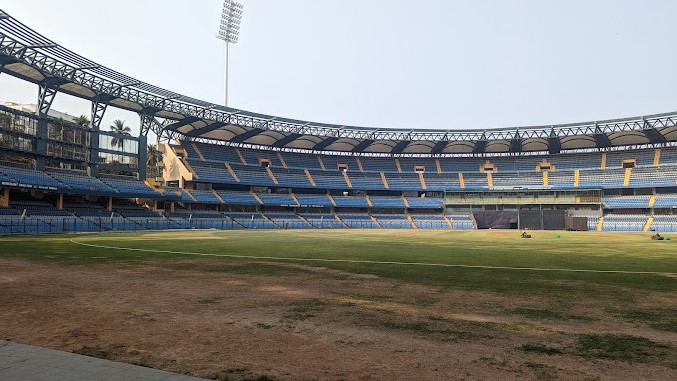Wankhede Stadium, located in Mumbai, India, is one of the most iconic and historic cricket grounds in the world. With a rich legacy and a reputation for hosting some of the most memorable cricket matches, Wankhede Stadium has become a symbol of cricketing excellence. Whether it’s hosting international matches, the Indian Premier League (IPL), or high-profile test series, the stadium has always been a favorite among players and fans alike. One aspect that often generates discussion is the boundary length of the ground, a key factor that influences how the game is played, particularly in limited-overs formats like T20s.
In this article, we will dive into the boundary length at Wankhede Stadium, compare it with other famous cricket grounds around the world, and analyze how the boundary size impacts the game. By understanding the dimensions of the field, we can better appreciate the strategies and performances that unfold at this legendary venue.
1. Introduction to Wankhede Stadium
Wankhede Stadium, officially known as the “Dr. D.Y. Patil Sports Complex,” is located in the heart of Mumbai, India. This stadium has hosted numerous unforgettable moments in cricket, including the 2011 ICC Cricket World Cup Final, where India triumphed over Sri Lanka to win the prestigious title.
Wankhede has a seating capacity of over 33,000, making it one of the largest stadiums in the country. It is home to the Mumbai Indians (MI) franchise in the IPL, and it regularly hosts international matches across formats, including Test matches, One-Day Internationals (ODIs), and Twenty20 (T20) games.
The boundary length at Wankhede is an important factor in these high-scoring games, especially in T20s. Its size is carefully designed to encourage big-hitting, creating a thrilling atmosphere for spectators and players alike. So, how long is the boundary at Wankhede, and what are the implications of its dimensions on the game?
2. Boundary Length at Wankhede Stadium
The boundary length of a cricket ground refers to the distance from the center of the pitch to the perimeter of the playing field. The boundary is a critical factor in determining how easy or difficult it is for batters to hit boundaries (4s) or sixes (6s).
At Wankhede Stadium, the boundary dimensions are as follows:
| Side of the Ground | Length (Meters) |
|---|---|
| Straight Boundaries | 65 – 70 meters |
| Square Boundaries | 60 – 65 meters |
| Deep Mid-Wicket to Deep Long-On | 70 – 75 meters |
| Powerplay Zone | 55 – 60 meters |
Explanation of the Table:
- Straight Boundaries: The straight boundaries, especially on the side of the pitch, typically measure between 65 and 70 meters.
- Square Boundaries: These boundaries, which are on the offside and leg side of the field, tend to be a bit shorter at around 60 to 65 meters.
- Deep Mid-Wicket to Deep Long-On: These boundaries, which run along the mid-wicket and long-on areas, are slightly longer, measuring around 70 to 75 meters.
- Powerplay Zone: The boundaries within the powerplay zone (the first six overs of a T20 match) are generally shorter, around 55 to 60 meters, giving batters a higher chance of hitting boundaries.
3. Comparing Wankhede with Other Cricket Grounds
To truly understand the significance of Wankhede’s boundary lengths, it’s essential to compare it with other famous cricket grounds. Stadiums like the Melbourne Cricket Ground (MCG), Eden Gardens, and Lord’s have different boundary lengths that impact how the game is played. The boundary length is a critical factor that can favor aggressive batters or give bowlers an edge depending on the dimensions.
Here is a comparison of the boundary lengths at Wankhede Stadium with some of the most famous cricket stadiums around the world:
| Stadium | Straight Boundaries (Meters) | Square Boundaries (Meters) | Notes |
|---|---|---|---|
| Wankhede Stadium | 65 – 70 meters | 60 – 65 meters | Smaller boundaries ideal for T20 and IPL cricket. |
| Melbourne Cricket Ground (MCG) | 70 – 74 meters | 65 – 70 meters | Larger boundaries, favoring bowlers and ground fielding. |
| Eden Gardens | 70 – 74 meters | 65 – 70 meters | Larger boundaries, giving an advantage to bowlers. |
| Lord’s Cricket Ground | 71 – 73 meters | 55 – 60 meters | More symmetrical, but still larger than Wankhede’s square boundaries. |
| Old Trafford | 65 – 70 meters | 60 – 65 meters | Similar dimensions to Wankhede but generally known for swing bowling. |
As can be seen, Wankhede Stadium’s boundaries are generally shorter compared to other prominent international stadiums. These smaller boundaries make Wankhede an exciting venue for high-scoring games, particularly in T20s, where hitting boundaries is key to setting competitive totals.
4. Impact of Wankhede’s Boundary Length on the Game
The boundary length at Wankhede has a significant impact on how matches are played, especially in the shorter formats of the game like T20 and ODIs. Let’s look at some of the ways in which these boundary dimensions affect the gameplay:
A. Batting Advantages
- Power Hitters: The shorter boundary length plays to the advantage of big hitters. Players with power-hitting capabilities, such as Rohit Sharma, Kieron Pollard, and AB de Villiers, find it easier to clear the boundary. These players are likely to score more boundaries and sixes, leading to higher run rates.
- Aggressive Batting: In T20 cricket, where the focus is on scoring quickly, the shorter boundaries make it easier for batters to take risks and play aggressively, knowing they have a good chance of clearing the fence.
- Faster Scoring: Teams can accumulate runs more quickly due to the frequency of boundaries. This creates an exciting atmosphere and attracts more fans to the stadium.
B. Bowling Challenges
- Difficulty for Bowlers: Bowlers, particularly fast bowlers, find it harder to control the game on shorter grounds. They are often forced to adjust their length, bowling shorter or wider deliveries, which can be easily dispatched by the batters.
- Risk of Overthrow: With shorter boundaries, even mis-hits or poorly executed shots can easily turn into boundaries or sixes, increasing the risk for bowlers.
C. Fielding
- Pressure on Fielders: Fielders on the boundary line have a significant job in stopping boundaries. They have less time to react compared to larger grounds and must be quick to prevent the ball from crossing the boundary line.
- Strategic Placement: Teams often place more fielders in the deep to prevent big hits, and the placement of these fielders becomes crucial in minimizing runs.
5. IPL and Wankhede Stadium’s Boundary Dynamics
Wankhede Stadium is known for being the home ground of the Mumbai Indians in the Indian Premier League (IPL), one of the most popular and lucrative T20 leagues in the world. The shorter boundaries at Wankhede play a crucial role in the high-scoring nature of IPL games.
A. Big Scores in IPL
- High-Scoring Matches: Wankhede Stadium regularly witnesses high-scoring encounters, with teams often posting totals in excess of 200 runs. The short boundaries make it easier for big hitters to clear the fence, leading to explosive batting performances.
- Fan Engagement: The prospect of sixes and fours being hit frequently adds to the excitement, engaging fans and creating a more thrilling atmosphere at the stadium.
B. Impact on Batting Strategies
- Aggressive Batting Orders: Teams in the IPL tend to go for more aggressive batting line-ups, often sending power hitters to the crease early on. This aggressive strategy is enhanced by the short boundaries, which increase the likelihood of clearing the fence.
- Middle-Over Explosions: The middle overs of a T20 match at Wankhede are often marked by explosive batting, as players know they have a higher chance of hitting boundaries, especially when the field is spread.
Wankhede Stadium’s boundary length plays a significant role in shaping the game’s dynamics, particularly in the T20 format. With shorter straight and square boundaries, the ground favors big hitters and creates an exciting atmosphere for both players and fans. Whether it’s international cricket or the IPL, the smaller dimensions at Wankhede result in higher-scoring games and thrilling moments that keep the crowd on the edge of their seats.
As we’ve seen, Wankhede’s boundary lengths are smaller compared to other international grounds, making it a venue that is well-suited for aggressive batting. This unique feature of the stadium adds to the charm of playing and watching cricket in Mumbai. So, the next time you watch a match at Wankhede, pay close attention to the boundaries, as they significantly impact how the game unfolds, and play a key role in the excitement and drama of modern-day cricket.

